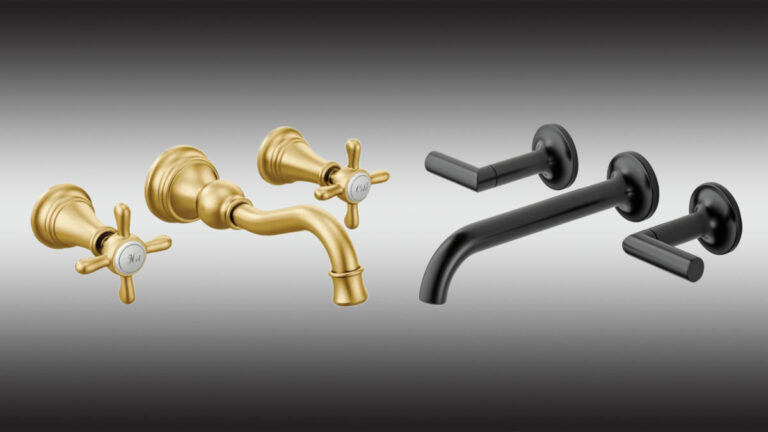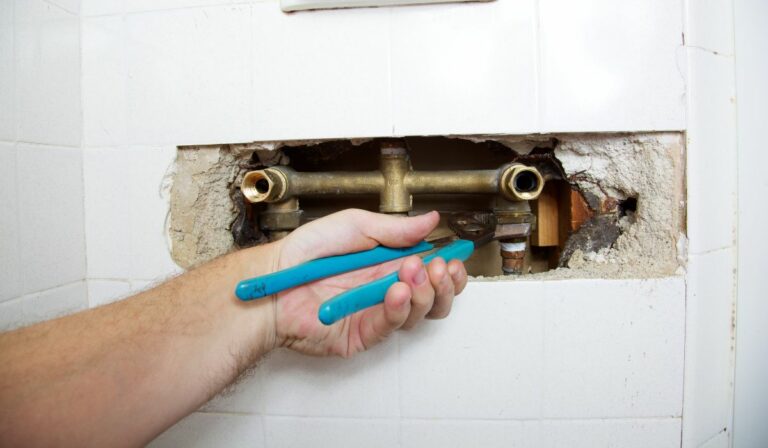How to Change Shower Drain Cover
To change your shower drain cover, first clear the area and clean around the drain. Use a screwdriver or flat tool to remove the old cover, whether it’s screwed or pressed in. Clean the drain opening thoroughly and choose a replacement cover that matches the size and type. Secure the new cover in place and seal it if needed. Keep going, and you’ll find simple tips to make the process even smoother and maintain your new drain cover longer.
Tools and Materials Needed
Before you begin replacing your shower drain cover, gather all the necessary tools and materials to ensure a smooth process. You’ll need a new drain cover that fits your shower drain size and type.
Grab a screwdriver—usually a flathead or Phillips—depending on the screws your old cover uses. Keep a utility knife handy to cut away any old caulk or sealant. Have a pair of pliers ready in case you need to loosen any stuck parts.
It’s also helpful to have some plumber’s putty or silicone caulk to seal the new cover securely. Finally, keep a towel or small bucket nearby to catch any water during the swap.
With everything at hand, you’ll make the replacement quick and hassle-free.
Preparing the Shower Area
When you start preparing the shower area, make sure to clear out any personal items and thoroughly dry the surface around the drain. This helps prevent slips and ensures a clean workspace.
Next, inspect the drain for any visible grime or soap scum, and clean it with a mild detergent and a scrub brush. Rinse well and dry completely to avoid moisture interfering with the new drain cover installation.
If you notice any mold or mildew, treat it with an appropriate cleaner and let it dry fully.
Also, check the drain’s edges for damage or corrosion that might affect the fit of the new cover.
Removing the Old Drain Cover
Although it might seem straightforward, removing the old drain cover requires some care to avoid damaging the drain or surrounding tiles. Start by checking if the cover is screwed in place. If it is, use a screwdriver to carefully remove the screws. Keep them in a safe spot in case you need them later.
If the cover isn’t secured with screws, it might be held by adhesive or simply pressed in. Gently pry it up using a flathead screwdriver or a putty knife, inserting the tool under the edge and lifting slowly. Avoid forcing it to prevent cracking the tiles or bending the drain lip.
Once loose, lift the cover off completely, setting it aside for disposal or reuse.
Cleaning the Drain Opening
Why does cleaning the drain opening matter? It ensures a secure fit for your new drain cover and prevents clogs or slow drainage.
Start by removing any visible debris like hair or soap scum using gloves or tweezers. Next, scrub the opening gently with an old toothbrush and a mixture of baking soda and vinegar to break down buildup and kill bacteria.
Rinse thoroughly with hot water to flush out loosened grime. Take care not to push debris further down the drain, as that could cause blockages.
Finally, dry the area completely with a cloth or paper towel to prevent mold or mildew growth before installing the new cover.
A clean drain opening sets the stage for a smooth replacement and optimal shower performance.
Selecting the Right Replacement Cover
Because your new drain cover needs to fit perfectly, choosing the right replacement is crucial. Start by measuring the diameter of your existing drain opening—most covers come in standard sizes, but exact measurements ensure a snug fit.
Check the material of your old cover too; options typically include stainless steel, plastic, or brass. Consider durability and how the cover matches your shower’s style.
Also, look at the type of drain cover you currently have—some are flat, while others are domed or have a grid pattern. Make sure the replacement matches this style for proper drainage and appearance.
Finally, verify if your shower drain requires a screw-in or snap-in cover to avoid mismatches. Taking these steps helps you pick a functional and fitting new drain cover.
Installing the New Shower Drain Cover
Once you’ve chosen the right replacement cover, you’re ready to install it. Start by cleaning the drain opening to remove any debris or old sealant.
If the new cover requires screws, align it with the drain holes and secure it using a screwdriver.
For pop-in covers, simply press it firmly into place until it sits flush with the shower floor.
Make sure the cover is centered and level to prevent water pooling.
If your cover uses a gasket or sealant, apply it evenly to ensure a tight fit and prevent leaks.
Finally, double-check that the cover is stable and properly attached before moving on.
Proper installation ensures your shower drain functions smoothly and looks neat.
Testing the New Drain Cover
How can you be sure your new shower drain cover is working properly? First, run water over the drain to check for any leaks or pooling. Watch closely to see if water flows smoothly without backing up.
Next, press gently on the cover to ensure it’s securely attached and doesn’t shift or wobble. If your drain cover has screws, double-check they’re tight but not overtightened. Also, look for any gaps between the cover and the drain edge that could allow debris through.
Finally, test how easy it’s to remove and replace the cover for future cleaning. If everything feels stable and the water drains efficiently, your new drain cover is installed correctly and ready for use.
Tips for Maintaining Your Shower Drain Cover
Keeping your shower drain cover in good shape helps prevent clogs and extends its lifespan. To maintain it, clean the cover regularly by removing hair and debris with a brush or cloth.
Avoid harsh chemicals; instead, use mild soap and warm water to prevent damage.
Check the screws or clips that hold the cover in place to ensure they’re tight, preventing loosening over time.
If you notice rust or wear, consider replacing the cover promptly to avoid leaks or further damage.
Also, avoid dropping heavy objects on the cover to prevent cracking.
Frequently Asked Questions
Can I Change a Shower Drain Cover Without Draining the Water?
You can change a shower drain cover without draining water if it’s easily accessible and not sealed tightly. Just remove the screws or clips carefully, then replace the cover. Avoid forcing it to prevent damage.
Are There Eco-Friendly Materials for Shower Drain Covers?
Yes, you can find eco-friendly shower drain covers made from recycled metals, bamboo, or biodegradable materials. These options reduce environmental impact while maintaining durability. You’ll enjoy a greener bathroom choice without sacrificing style or function.
How Often Should I Replace My Shower Drain Cover?
You should replace your shower drain cover every 1-2 years or sooner if it’s cracked, rusted, or clogged beyond cleaning. Regular checks help maintain proper drainage and prevent mold or unpleasant odors from developing.
Will a New Drain Cover Prevent Hair Clogs Entirely?
No, a new drain cover won’t completely stop hair clogs, but it can reduce them. You’ll still need to clean regularly and use hair-catching tools to keep your drain flowing smoothly and avoid blockages.
Can I Upgrade to a Drain Cover With a Built-In Hair Catcher?
Yes, you can upgrade to a drain cover with a built-in hair catcher. It’ll help trap hair before it clogs your drain, making maintenance easier and reducing the need for frequent cleaning or plumber visits.
Conclusion
Changing your shower drain cover is a simple task you can handle yourself with the right tools and a bit of care. By removing the old cover, cleaning the drain opening, and installing a properly sized replacement, you’ll keep your shower looking neat and functioning well. Remember to test the new cover to ensure a secure fit. With regular maintenance, your drain cover will stay in great shape, preventing clogs and prolonging its lifespan.


